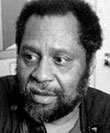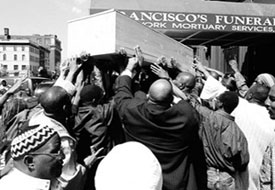
NEW YORK (FinalCall.com)–Black New Yorkers are saying publicly that it is dangerous to be Black in the “Big Apple.” They are referring to a recent rash of police killings and beatings.
“To further the ‘shock and awe’ program in the Black community, doors will continue to be rammed in. Black women and children will not be safe in their homes, and far too many Black men remain in jail or homeless,” community activist Alton H. Maddox Jr. said.
On May 16, Alberta Spruill, 57, died of cardiac arrest after 12 police officers broke down her door, threw a stun-grenade at her, and handcuffed her. When they realized they had the wrong apartment, she was dead. The Manhattan district attorney is investigating.

On May 23, Ousmane Zongo, 43, a West African immigrant died from four bullets fired from the gun of a 24-year-old police officer. According to reports, the first shot quite possibly blasted a hole in his chest “large enough to put a finger through.” The New York Police Department (NYPD) has this case under investigation. Rev. Al Sharpton has demanded an independent investigation.
“Blacks better realize the need to watch their backs wherever they are–including in their own homes,” Rev. Herbert Daughtry, the veteran civil rights activist, said during a press conference to discuss police abuse in Brooklyn, echoing Mr. Maddox.
On June 4, Jose Mateo, 22, died after being peppered-sprayed by two police officers. His father said they called 911 for an ambulance because his son had a stomach ache, but the officers arrived first. The officers have said that they found Mr. Mateo attacking his father.
Police Commissioner Ray Kelly defended the officers’ action, saying they had to subdue a “violent, apparently high man.” There was no scuffle or violence before the cops sprayed his son in the eyes, the father said. The commissioner said his officers did not use excessive force.
Observers say the killing of unarmed citizens by the NYPD has created a legacy of fear evidenced in the spiraling civilian complaints against police officers. The number of complaints of police abuse increased 18.2 percent from 1,510 to 1,785 in the first four months of 2003–compared with the same period in 2002, according to the Civilian Complaint Review Board.
Most of the complaints were due to “excessive force or abuse of authority.” The review board did not explain why complaints increased, but did say that statistics show that Blacks are disproportionately the victims of police abuse.
Mayor Michael Bloomberg attempted to defuse the fear and anger in the Harlem community by attending the funeral of Ms. Spruill.
“There is no pattern of police brutality,” Mr. Bloomberg stressed. “I don’t think there is any evidence that there is a trend in police misconduct,” the mayor said. “There were a couple of incidents that should never have happened.”
“It is easy for those who do not live in our community to dismiss the fear, deny the anger is justified,” Rev. Daughtry said.
“The police are basically out of control in our community,” an angry Lem Peterkin said during the Brooklyn press conference. Something must be done to stop such brutal behavior, the veteran press photographer added. He was referring to an encounter he had with a group of police officers attempting to take an alleged disturbed man into custody.
Mr. Peterkin said he identified himself as a press photographer, but ended up handcuffed and shoved into a police car. He also said that some of his equipment was damaged, and the film of the incident destroyed. “This has got to stop. I want this story told,” Mr. Peterkin explained to The Final Call. “I am ready to meet with anyone concerned about the brutal activities of the NYPD.”
“I just wish things would be different, at least by now,” Kadiatou Diallo, the mother of Amadou Diallo, who died in a hail of 41 bullets in 1999 in his Bronx apartment hallway. Four White police officers said they thought his wallet was a gun, and a jury found them not guilty in Mr. Diallo’s murder.
“It’s been a long time, and we have been talking and asking for change,” Ms. Diallo said during a local radio interview.
“Nothing has changed in the NYPD, not even the discrimination in hiring issue has gone away,” Sgt. Anthony Miranda, head of the N.Y. chapter of the National Latino Police Officers Association, told The Final Call. He said there is a state of hysteria in the activist community created by the “9-11 frenzy.”
“Everyone is walking on eggshells because to speak out against law enforcement is to be painted as un-American,” Sgt. Miranda said.
“But we’d better stop the eggshell foolishness, because our communities are hurting from the repressive tactics under Homeland Security and the Patriot Act. A week after Ms. Spruill died, the NYPD raided an apartment complex in Queens, and they kicked in the door of each apartment, using ‘no-knock warrants’ and keeping things quiet,” Sgt. Miranda added.
Commissioner Kelley, in a 24-page report describing the NYPD investigation into Ms. Spruill’s death, said mistakes were made, and promised reforms, such as a new computer system to keep track of informants and all search warrants that are issued because of an informant’s information.
“The commissioner is stroking the public. We already have a citywide tracking system on informants. The search warrant issue is not about ‘no-knock warrants’ per se, but about the pressure being placed on precinct commanders to show high numbers of search warrants, to show they are fighting crime,” Sgt. Miranda said.
At a recent city council hearing on the “no-knock warrant” problem, Brooklyn Democratic Councilman Charles Barron asked the police commissioner why so many “no-knock warrants” were issued in predominately Black and Latino neighborhoods. Mr. Kelley said officers respond where crime is high. He added that the police department’s motive is to make neighborhoods safer, not to target minorities, as some have suggested.
Mr. Kelley told the council that from January 1, 2001 to April 30, 2003, there were 12,950 warrants issued and that 90 percent found contraband. He said a vast majority of the warrants were “no-knock” involving narcotics. He also admitted that flash grenades have been used 85 times during 1,900 raids. “Search warrants are tools used to fight serious crime,” the commissioner said.
But activists, such as Lt. Eric Adams, head of 100 Blacks in Law Enforcement Who Care, and Norman Siegel, a Manhattan civil rights lawyer, have demanded to see the records of the NYPD on what weapons are used in which communities during police raids. They also want to know what role race may play in the use of “no-knock” warrants.
Manhattan courts gave up tracking search warrants a decade ago, a spokesman told The Final Call. A police department spokesperson said they did not believe they had statistics on search warrants served at the wrong address, and the Manhattan district attorney refused to discuss search warrants.
A dozen New Yorkers said police wrongly raided their homes, during a hearing called by Manhattan Borough President C. Virginia Fields on June 3. Ms. Fields told reporters that she had received 110 calls from people who said police wrongly raided their homes.
Mary Bardy told the city council on June 2 that her Queens home was wrongly raided over a year and a half ago. She said no drugs were found, and officers told her that they raided her home based on “bad” information.
“We never received an apology, but we are coming forward now because of Ms. Spruill’s death,” Ms. Bardy said.
However, Heather MacDonald, a fellow at the conservative think tank, The Manhattan Institute, and author of’”Are Cops Racists?” says that all the recent talk about racial profiling and police brutality is bad news for the war on terrorism. She said this is not the time to question police procedures, because such actions will cripple jurisdictions from adhering to policies that could prevent the next terrorist attack in America.
“Undoubtedly some individual officers have used race to fight against lawbreakers, but there is no evidence that this lazy and unprofessional practice is systemic,” Ms. MacDonald said.












